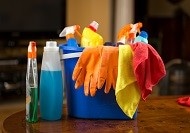Oct 5 2019
For generations, people have used chlorine bleach to clean and disinfect their homes. However, researchers have now discovered that bleach fumes, in combination with light and a citrus compound found in many household products, can form airborne particles that might be harmful when inhaled by pets or people. They report their results in ACS’ Environmental Science & Technology.
 Bleach can give off fumes that, when combined with light and a citrus compound found in many household cleaners and other products, can create indoor air pollutants. Credit: kryzhov/Shutterstock.com
Bleach can give off fumes that, when combined with light and a citrus compound found in many household cleaners and other products, can create indoor air pollutants. Credit: kryzhov/Shutterstock.com
Bleach cleaning products emit chlorine-containing compounds, such as hypochlorous acid (HOCl) and chlorine gas (Cl2), that can accumulate to relatively high levels in poorly ventilated indoor environments. These gases can react with other chemicals commonly found in homes, such as limonene –– an orange- or lemon-scented compound added to many personal care products, cleaners and air fresheners. In addition, indoor lighting or sunshine through windows might split HOCl and Cl2 into a hydroxyl radical and a chlorine atom, which can react with other compounds to form air particles called secondary organic aerosols (SOAs). These pollutants have been linked to respiratory problems and other adverse health effects. Chen Wang and colleagues wanted to see whether limonene and bleach fumes, at concentrations likely to occur in indoor environments, could react to produce SOAs under light and dark conditions.
The researchers added limonene, HOCl and Cl2 to air in an environmental chamber and then measured the reaction products using mass spectrometry. In the dark, limonene and HOCl/Cl2 quickly reacted to produce a variety of volatile compounds. When the team turned on fluorescent lights or exposed the chamber to sunlight, these volatile compounds interacted with the light-generated hydroxyl radicals and chlorine atoms to form SOAs. Although the composition and possible health effects of these particles need to be studied further, they could be occupational hazards for people involved in cleaning activities, the researchers say.
The authors acknowledge funding from the Chemistry of Indoor Environments program of the Alfred P. Sloan Foundation.